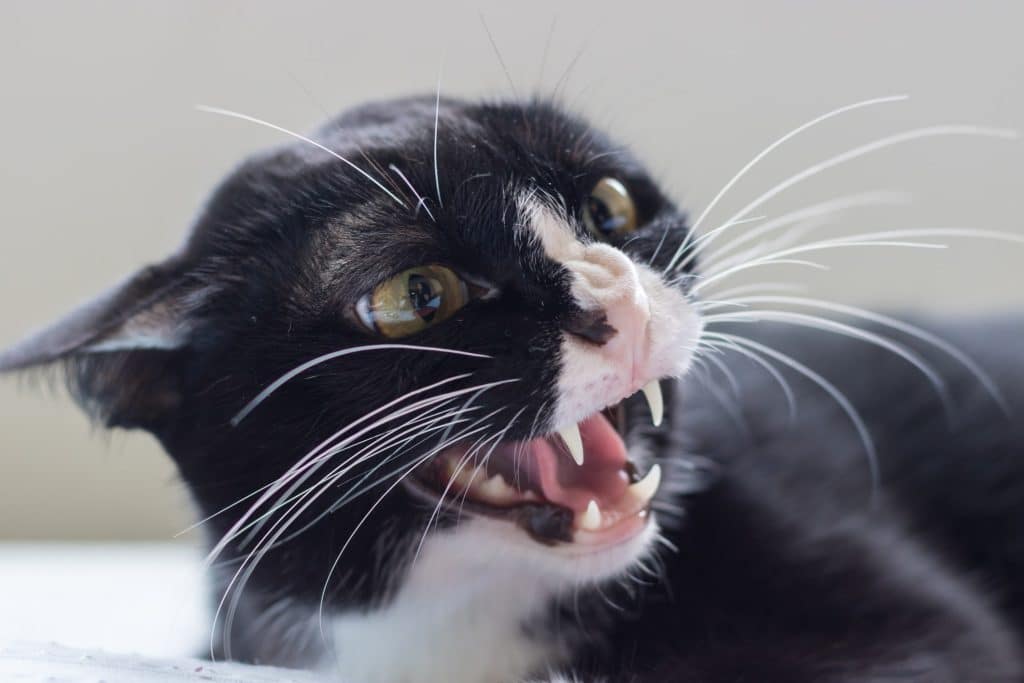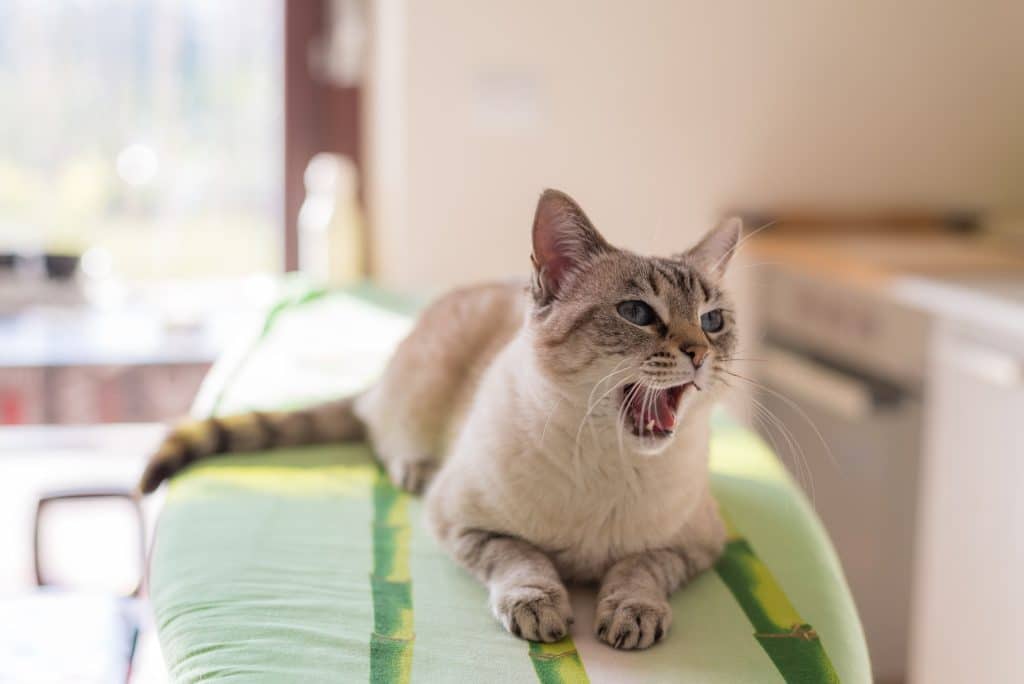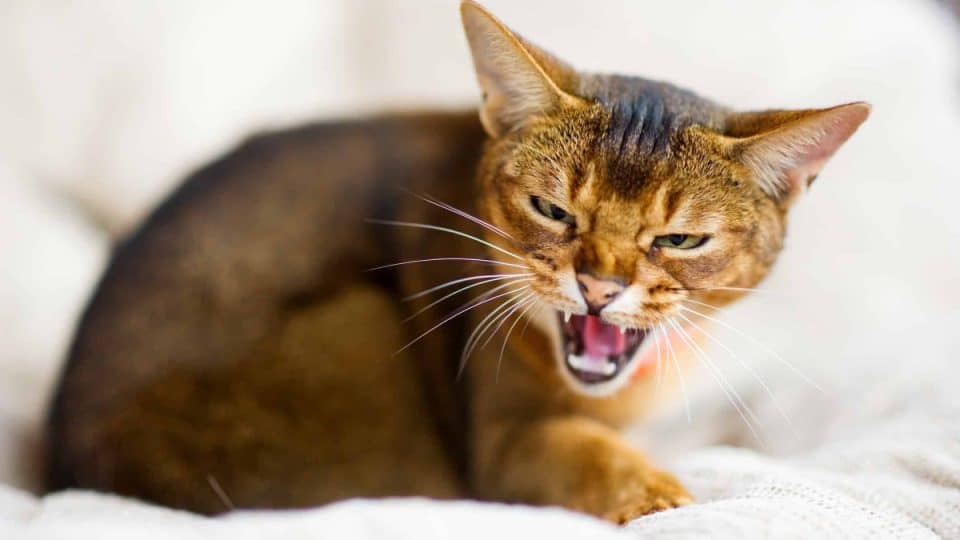Although cats can’t ‘speak’ like us, they are still vocal creatures, engaging in 21 vocalisation types. For example, we know purring can communicate affection, and meowing is a tactic to get attention. But what does it mean when cats growl?
Growling occurs for various reasons and can point to your cat’s physical or mental health. As a not-so-happy sound, it can be worrying to hear. However, it’s a normal vocalisation and behaviour for felines to engage in. Essentially, cats growl to communicate and warn others, shares Valerie Bennett, a clinical animal behaviourist at Animal Behaviour Business. For instance, she explains that growling might happen when they fight with other animals or even humans.
Additionally, growling allows cats to warn others without engaging in a physical altercation and potentially risking injury. While growling can occasionally occur, some felines use this vocalisation more regularly. But you can take steps to help reduce its frequency. Read on to learn how to distinguish a growl from other cute cat sounds, potential causes for growling, and how to respond when you hear it.
Do Cats Actually Growl?
We often associate growling with larger felines, such as lions and tigers. But smaller cats growl too! When a cat growls, it’s a long, deep, rumbling, throaty sound. While snarls sound similar, they are shorter in duration and more high-pitched. You might also notice your cat baring their teeth. Purring can also be a deep sound but is more rhythmic and non-threatening.

iStock/Moostocker
Bennett says their posture and behaviours can clue you in if you’re finding it difficult to differentiate. For example, she explains growling may be accompanied by piloerection (the standing up of hairs), an arched back, crouching, and hissing. Additionally, their ears might be flat, their eyes dilated, and they might attempt to hide.
5 Reasons Your Cat Is Growling
Numerous situations can cause a cat to growl, including fear, anxiety, or frustration. Below, experts explain the five most common culprits behind cat growling.
They’re being territorial
Sometimes, cats growl when trying to mark their territory. “Intrusion by unrelated individuals is poorly tolerated by a single cat or an affiliated group of cats,” Bennett explains. This leads them to growl as a warning to back off.
Additionally, Bennett adds cats are particularly territorial if they’re concerned their offspring are at risk of harm or think they might have to share their ‘resources’.
They’re letting other cats know who’s boss
Ever looked out of the window and spied your cat in a stand-off with another feline? You might not be able to hear them, but there’s a good chance your cat is busy growling.
“Growling often occurs due to social pressures, such as when two cats meet on disputed ground or when one cat is passing through another cat’s territory,” explains Nicky Trevorrow, behaviour manager at Cats Protection.

iStock/liebre
They’re scared, overstimulated, or stressed
If your cat is overwhelmed, they might start growling. “Cats will usually run from anything they think is a threat; they may growl as a warning if they can’t escape,” Trevorrow says.
She also highlights while humans can deal with more extended and more intense periods of socialising, cats are far less at ease in such situations. Often, this happens with cats who aren’t well socialised or those with a negative experience with humans. “Many have a limit to how much petting they can handle, which can result in aggressive behaviour,” she adds.
They’re sick or uncomfortable
When you’re hurt, you communicate that pain—our cats can’t. Since our felines can’t tell us when they’re uncomfortable or sick, Bennett says they might growl if someone tries to move or hold them as a warning to stay away.
They’re frustrated
Like humans, cats can become easily frustrated and growl. For instance, Trevorrow says an indoor cat might not receive enough stimulation and get annoyed. Additionally, she explains if your cat doesn’t have enough food or a clean litter box, they can growl in annoyance.
Another potential source of irritation, Trevorrow adds, is if your cat doesn’t have an outlet to engage their hunting instincts, “which can [then] present as misdirected predatory behaviour.”
How To Respond To Your Cat Growling
Growling is a typical sound for a cat, so don’t worry if you occasionally hear it. So what should you do when your cat is growling at you? Firstly, don’t ignore them: demonstrating the right behaviours can aid in putting them at ease and stopping the sound. While your instinct might be to pet your cat and give it lots of attention, remember that less is more when they’re feeling stressed out. Trevorrow explains that cats evolved from solitary animals and aren’t fans of crowding. Instead, she says pet parents should pay attention to their cat’s body language and respect their boundaries.
Additionally, creating a safe space for your cat to retreat to is vital. This will help reduce growling and stress and may even prevent it from arising in the first place. Finally, if the growling is persistent and annoying, never punish your cat. Trevorrow says punishment won’t help the situation or stop the behaviour. Instead, it’s more likely to stress them out even more.

iStock/fbxx
Does Growling Mean Your Cat Needs A Vet Visit?
Since growling is a natural cat behaviour, it doesn’t necessarily indicate your cat needs help. However, frequent growling can signal your cat is sick or in pain. So what might be going on? “Cats may growl for a variety of medical reasons, but they generally will all have one thing in common: pain,” reveals Dr Patrik Holmboe, head veterinarian for Cooper Pet Care.
Sometimes, the cause will be visible, such as an injury. On other occasions, however, Holmboe explains the root issue may be less apparent, and the growling might catch you off guard.
Some common medical causes of pain that can induce growling include the following.
- Urinary tract infections (UTIs). Pain with UTIs often happens during urination. Holmboe says other symptoms include frequent urination outside the litter box, blood in the urine, and excessive licking.
- Dental disease. Holmboe shares pain from tooth decay, gum disease, or a dental abscess can cause a cat to growl, especially when eating. Additional signs of dental disease include weight loss, decreased appetite, bad breath, and drooling.
- Arthritis. This disease can be trickier to diagnose fully. However, additional symptoms include limping, difficulty jumping, decreased activity, and changes in grooming habits.
- Gastrointestinal (GI) problems. Holmboe says GI conditions like pancreatitis, inflammatory bowel disease, constipation, or stomach aches can cause abdominal discomfort and cat growling. Signs of something more serious include changes in appetite, vomiting, diarrhoea, and weight loss.
If your cat shows any of these symptoms alongside growling, ask your vet to check things out or see a feline behaviourist.



